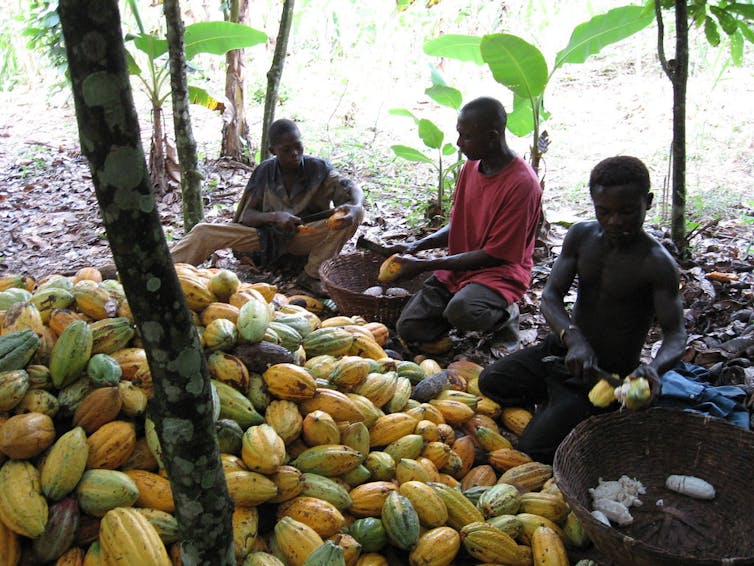
Marine Jouvin, Université de Bordeaux
The evidence of child labour on cocoa farms in West Africa became public knowledge in the late 1990s. This followed press reports documenting the existence of hazardous child labour on cocoa farms. Pressure on the cocoa industry to end child labour has been growing ever since, particularly from civil society and more recently from both US and European regulators.
To meet consumer demand for more sustainable and ethical cocoa, the industry began using certification schemes in the late 2000s. Certification labels, such as Rainforest Alliance and FairTrade, aim, among other goals, to guarantee cocoa produced without the use of child labour.
It is estimated that between one-third and one-half of the cocoa sold worldwide is currently certified.
In September 2001, by ratifying the Harkin-Engel Protocol, the cocoa industry committed to reduce the most hazardous forms of child labour by 70% by 2020. Yet, Côte d'Ivoire, the world’s largest cocoa producer, is still struggling with child labour on its cocoa farms.
Indeed, the number of children under the age of 18 working on cocoa farms (certified or not) actually increased between 2013 and 2019, to reach an estimated 790,000. It’s believed that 97% of them are engaged in some of the most hazardous work, including clearing land, harvesting cocoa with a machete, or applying agrochemicals on cocoa farms.
My new research paper focusing on certified cocoa farmers in Côte d'Ivoire argues that the real number of child labourers is likely even higher, as measures of child labour may be biased. The results also suggest that certification is not working as intended when it comes to child labour.
Child labour in cocoa
I found that the prevalence of child labour is likely being underestimated by studies conducted by both researchers and the cocoa industry. This is due to a concept called social desirability bias which occurs when people are reluctant to provide completely truthful answers about sensitive topics out of fear of negative consequences.
In the case of child labour on Ivorian cocoa farms, certified farmers may lie about their reliance on child labour as any type of child labour is prohibited by the certification schemes they belong to. Hazardous labour is also prohibited by national legislation.
Fear of legal, social, or economic repercussions is likely leading certified farmers to under report their use of child labour. This is making it harder to accurately measure the scope of the problem and to enact effective policies to fight it.
Sensitive questions
My study relied on a list experiment survey method. It asks respondents about sensitive topics in a more indirect manner than standard surveys.
The prevalence of child labour use estimated using the indirect measure is twice as large as the one from direct questioning. Using list experiments, I find that between 21% and 25% of the surveyed cocoa farmers were relying on child labour during the past 12 months, depending on the type of work involved. This difference suggests that at least half of Ivorian cocoa farmers who use child labour on their certified farms are not willing to admit it.
Why the reliance on children
Main drivers include failures in labour markets, lack of school infrastructure and difficulties in monitoring the use of child labour by certified cocoa farmers, mainly because of the remoteness of the farms.
Cocoa production requires a significant amount of physical labour, as many tasks associated with cocoa farming are not mechanised. Additionally, as cocoa prices in Côte d'Ivoire are fixed seasonally, the only way for farmers to increase their cocoa-generated income is to increase their production. This requires increased labour.
At the same time, Ivorian cocoa farms tend to be clustered in cocoa-growing communities. This means that local adult labour is scarce because most able-bodied adults are employed on their own cocoa farms, and are not seeking labour on other farms.
This labour market failure —- more labourers are needed precisely where they are not available — results in more cocoa farmers relying on child labour. This phenomenon is even more important when cocoa farms are located in remote communities with difficult access to roads. The reliance on child labour by cocoa farmers is then partly due to adult labour shortages. This finding is further borne out by the fact that the presence of an additional adult in a cocoa-growing household reduced the likelihood of relying on child labour up to 4%.
I also found that the prevalence of child labour is higher on more remote farms, which can be explained by weaker law enforcement in these areas, fewer available adult labourers, and limited opportunity for children to attend school due to a lack of school infrastructure.
Conclusion
Taken together, these findings strongly suggest that child labour rates, and potentially other sensitive subjects, are not being measured accurately. In addition, they show that the issue of child labour remains rampant in Côte d'Ivoire, even on cocoa farms certified as child-labour-free.
Understanding the various reasons behind farmers’ continued use of child labour and reluctance to admit that use is an important first step in designing more effective policies. By taking the phenomenon of social desirability bias into account in future research, governments and development partners can lead to more accurate measures of the issue and inform more effective policymaking.![]()
Marine Jouvin, PhD Candidate in development economics, Université de Bordeaux
This article is republished from The Conversation under a Creative Commons license. Read the original article.

